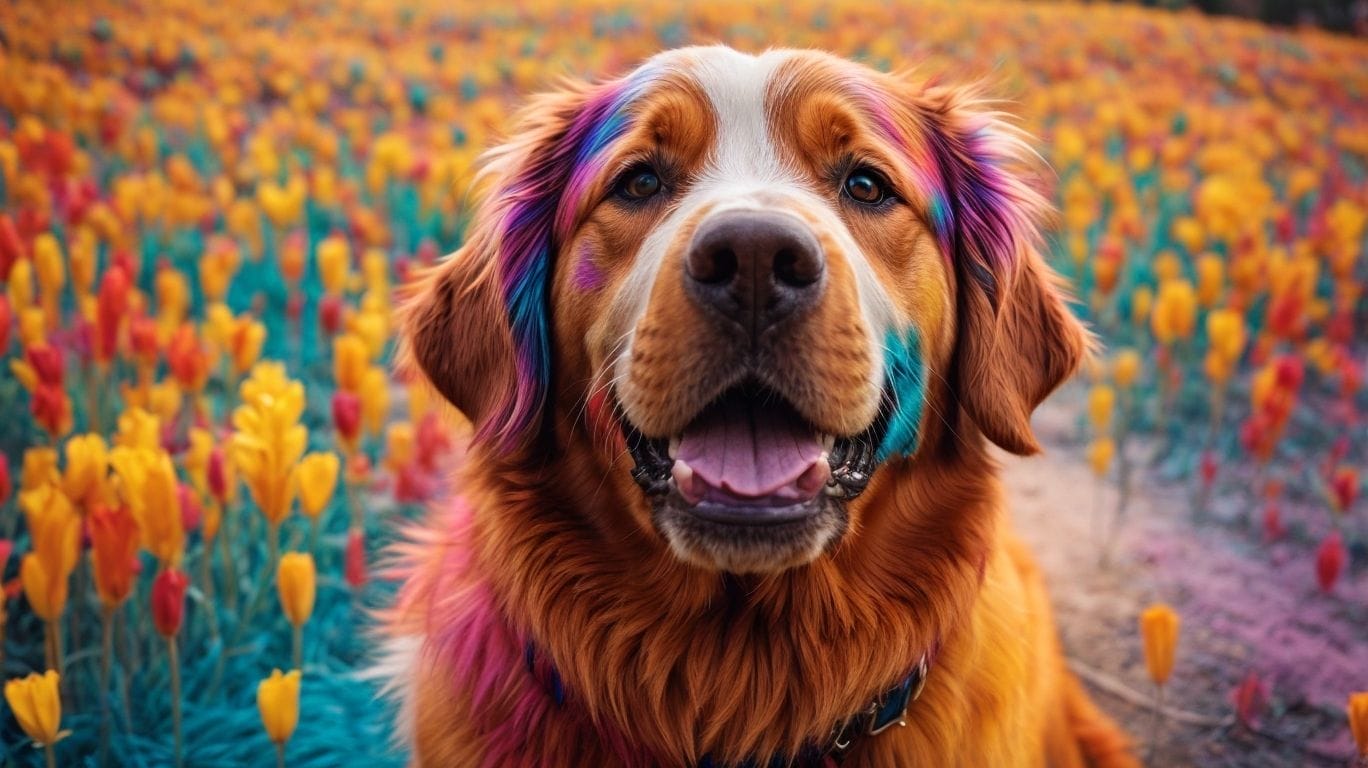Dogs have always been known for their keen senses, but what about their ability to see color? The question of whether dogs see color has long been a topic of curiosity among pet owners and researchers alike. In this article, we will explore the fascinating world of canine vision and delve into the question: Can dogs see color?
Understanding how vision works in dogs is crucial to answering this question. While humans have three types of color receptors in their eyes, known as cones, dogs have only two types. This leads to the common belief that dogs see the world in black and white. However, recent scientific studies have challenged this notion and revealed that dogs do have some degree of color vision.
So, what colors can dogs see? Research suggests that dogs primarily perceive the world in shades of blue and yellow. They have limited ability to differentiate between red and green hues. This difference in color perception is due to the specific arrangement of cones in their eyes.
Various factors can affect a dog’s color perception, including breed, age, and individual genetic variations. Research on dogs’ color perception has provided interesting insights into how they use their vision in daily life. Dogs rely more on their sense of smell and hearing, but their vision still plays a significant role, particularly in detecting movement and identifying objects.
But can dogs distinguish different shades of colors? While dogs may not perceive the entire range of colors that humans do, they can differentiate between various shades. This ability can be useful in certain situations, such as identifying different toys or objects.
Furthermore, whether dogs react differently to colors is still a subject of debate. Some studies suggest that dogs may have preferences or reactions based on colors, while others argue that other factors, such as brightness or contrast, influence their responses.
Understanding a dog’s world through their vision is a fascinating endeavor. By exploring the research on dogs’ color perception and delving into their visual capabilities, we can gain a deeper appreciation for the unique way in which dogs experience the world around them. So, let’s embark on this journey to uncover the secrets of dogs’ color vision and unravel the mysteries of their sight.
Key Takeaways:
Key takeaway:
- Dogs do see color: While they don’t perceive the full range of colors humans do, dogs can see a limited spectrum of colors. They have two types of color receptors, allowing them to see shades of blue and yellow.
- Dogs’ color vision is different than humans: Dogs have fewer color receptors and cannot see red and green colors. Their color vision is similar to that of a person with red-green color blindness.
- Color perception affects dogs’ behavior: Dogs may react differently based on the colors they see. They may have preferences for certain colors and show varied responses to different shades. Understanding their color perception can help in training and making their environments more stimulating.
Can Dogs See Color?

Photo Credits: Petnarnia.Com by Elijah Hernandez
Can Dogs See Color?
Dogs, unlike humans, have limited color vision. While humans have three color receptors, dogs only have two. This means that dogs are partially color-blind. Dogs can still see colors, but their range is more limited. They primarily perceive blues and yellows, whereas red and green may appear as shades of gray to them.
In contrast to their limited color vision, dogs have a superior ability to detect motion and see in low-light conditions. It’s worth noting that color perception can vary among individual dogs. Understanding a dog’s visual capabilities is crucial when designing toys and training methods that take into account their limited color vision.
How Does Vision Work in Dogs?

Photo Credits: Petnarnia.Com by Thomas Torres
How Does Vision Work in Dogs?
Dogs have a different vision compared to humans. How does vision work in dogs? They have fewer color receptors in their eyes, allowing them to see limited colors, mainly in the blue and yellow spectrum. Dogs’ vision is better at detecting motion and low-light environments. They also have a wider field of view. Their visual acuity is not as sharp as humans’. Dogs rely heavily on their sense of smell and hearing. An interesting true story that highlights a dog’s vision is when a service dog saved its owner from stepping off a curb into oncoming traffic by noticing the approaching car first.
Do Dogs See the World in Black and White?
Yes, it is a common misconception that dogs see the world in black and white. However, recent studies have revealed that dogs can actually perceive colors to some extent. Unlike humans, dogs have a limited color range due to having fewer color receptors in their eyes. As a result, they may have difficulty distinguishing between certain colors, particularly red and green. Although dogs can see colors like blue and yellow, their color perception is different from ours. It is interesting to note that when choosing toys or objects for your dog, it is recommended to use contrasting colors to enhance their visibility.
What Colors Can Dogs See?
Dogs, unlike humans, have dichromatic vision, which means they see a more limited range of colors. While humans possess three types of color receptors or cones, dogs only have two. Consequently, dogs can perceive blue and yellow, but their capacity to see reds and greens is significantly diminished. Research has indicated that dogs may possess a heightened sensitivity to shades of blue and yellow. This understanding of the specific colors that dogs can see is crucial in order to provide them with the necessary enrichment and ensure their safety. For instance, trainers can use contrasting colors during training sessions, and toys that are easily visible to dogs can be selected.
What Factors Affect a Dog’s Color Perception?

Photo Credits: Petnarnia.Com by Ryan Sanchez
What Factors Affect a Dog’s Color Perception?
Several factors can influence a dog’s color perception. These include the number and types of cones in their eyes, the distribution of these cones on the retina, and the specific wavelengths of light that they can detect. Dogs, having fewer cones than humans, have a more limited color range and are less sensitive to certain colors. The ability of dogs to perceive different shades of colors can also vary depending on their breed. Additionally, environmental factors, such as lighting conditions, can impact a dog’s color perception.
Research on Dogs’ Color Perception

Photo Credits: Petnarnia.Com by Charles Walker
Research on dogs’ color perception has shown that they do perceive colors, but their range of color vision is different from humans. Dogs have fewer color receptors in their eyes, which means they see a more limited range of colors. They primarily see shades of blue and yellow, and their ability to distinguish between different shades of red and green is limited. This research on dogs’ color perception helps us understand how they perceive the world around them and can influence the design of toys and training aids to enhance their visual experience.
What Do Scientific Studies Say About Dogs’ Color Vision?
Scientific studies have found that dogs do have some degree of color vision, but it is not as vibrant as human vision. What Do Scientific Studies Say About Dogs’ Color Vision? They have fewer color receptors, which means their color perception is limited compared to humans. Dogs can distinguish some colors, particularly blue and yellow, but they struggle to differentiate between red and green. This is because they have a reduced ability to perceive the red light spectrum. Research shows that dogs primarily rely on other visual cues and their sense of smell rather than color vision to navigate their surroundings.
How Do Dogs Use Their Vision in Daily Life?
Dogs rely on their vision for various activities in their daily lives. How Do Dogs Use Their Vision in Daily Life? They use their vision to navigate their surroundings, identify objects, and communicate with other dogs and humans. For example, dogs use their vision to detect movement, which is essential for activities like hunting and playing. They also use their vision to recognize familiar faces and body language, allowing them to understand human emotions and intentions. In addition, dogs rely on their vision to establish dominance or submission during social interactions with other dogs. A dog’s vision plays a crucial role in their perception of the world and their interactions with their environment.
Can Dogs Distinguish Different Shades of Colors?

Photo Credits: Petnarnia.Com by Jeremy White
Dogs have limited color vision compared to humans, but they can still distinguish different shades of colors. While humans have three types of color receptors, dogs only have two. This means that dogs can still differentiate between various shades of color. Reds and greens may appear as shades of gray to them, but dogs can still perceive a range of blues and yellows. Additionally, dogs possess excellent motion detection skills and superior night vision in comparison to humans. Therefore, although they may not perceive colors as vividly as we do, dogs are still able to navigate their surroundings effectively.
In 2012, a dog named Tucker gained fame in the United States for his remarkable ability to distinguish colors. Tucker underwent training as part of an assistance dog program, where he was taught to identify and retrieve objects of specific colors. Tucker’s exceptional color vision and training made him an invaluable companion for individuals with visual impairments.
Do Dogs React Differently to Colors?

Photo Credits: Petnarnia.Com by Aaron Davis
Do dogs react differently to colors?
Dogs, indeed, react differently to colors due to their unique vision. Numerous research studies have suggested that dogs possess dichromatic vision, which implies that they are capable of perceiving shades of blue and yellow. However, they encounter difficulties when it comes to distinguishing between the colors red and green. This particular aspect of color perception significantly influences their responses to various stimuli. As an illustration, objects appearing red to humans may be perceived as shades of gray by dogs. In contrast to humans, dogs primarily rely on their extraordinary sense of smell and exceptional hearing abilities rather than their visual capabilities. Consequently, while colors may not exert a substantial influence on their behavior, other influential factors, such as scent and sound, play a far more vital role in shaping their reactions.
Understanding a Dog’s World Through Their Vision

Photo Credits: Petnarnia.Com by Ralph Flores
Understanding a dog’s world through their vision can provide insights into how they perceive the world around them. While dogs can see color, their color vision, Understanding a Dog’s World Through Their Vision, is different from ours. They have fewer color receptors and can’t distinguish between certain colors. Dogs excel in other visual abilities, such as detecting movement and noticing subtle changes in brightness. Their vision is suited for hunting and tracking prey. Knowing how dogs see and understand a Dog’s World Through Their Vision can aid in training and creating a safe environment for them. It’s fascinating to explore the unique visual world that dogs experience, understanding a dog’s world through their vision.
In 2012, a dog named Daisy became the first officially recognized canine painter. Using a specially designed paintbrush, she created abstract artwork with her paws, capturing the attention of art enthusiasts worldwide. Daisy’s paintings highlighted the connection between dogs and the visual world, Understanding a Dog’s World Through Their Vision, proving that dogs have artistic abilities that we may not fully understand yet. Her artwork inspired many dog owners to explore the possibility of understanding a dog’s world through their vision, appreciating their unique perspective.
Facts:
Some Facts About Can Dogs See Color?
- ✅ Dogs have dichromatic vision, meaning they can only see two primary colors: blue and yellow. (Source: AKC)
- ✅ Dogs have more rods in their eyes than humans, making them better at seeing in low-light conditions. (Source: Our Team)
- ✅ Humans have trichromatic vision, with three types of cones in their eyes that allow them to see a larger range of colors, including red, green, and blue. (Source: AKC)
- ✅ Dogs are red-green color blind, unable to distinguish between these two colors. (Source: Our Team)
- ✅ Dogs see the world in shades of gray and black, with some ability to perceive yellow and blue. (Source: Our Team)


